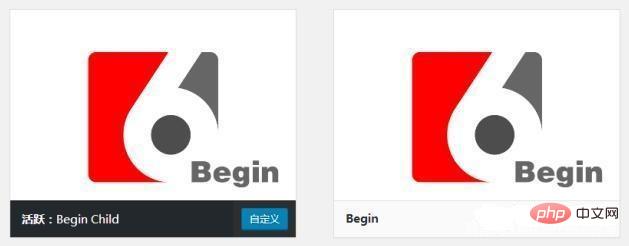How to add a wordpress child theme

Introduction and principle of WordPress child theme
WordPress provides the child theme function, allowing us to use child themes Modify the WordPress theme without directly modifying the source code, and content that cannot be updated appears. A child theme needs to have a parent theme to be enabled. According to the main file of the WordPress theme, if the child theme exists, WordPress will automatically use the file of the child theme and abandon the use of the parent theme.
In this way, which file of the parent theme we want to modify first, we can copy the file to the child theme, and then modify the file, so that the purpose of modification can be achieved. Of course, only WordPress theme core files can be identified and replaced, and most themes have many other files that cannot be modified in addition to the main files.
1. Why use subthemes?
Every time you use a theme, there may be some changes that may need to be made to suit your needs. For example, some are blog themes and want to be turned into CMS magazine themes. Some links in the topic, such as the irrelevant links at the bottom, must be changed if you want to remove the link. (If the author links to the topic, it is recommended to keep the source and use it for free. Keeping the link is the greatest respect.) In the process of modifying the original topic countless times, you will suddenly forget what you changed. Once you make a mistake, you have to Again. Or, once the author of the original theme updates and upgrades, and you need to update and upgrade, you find that you may need to modify it again. In this way, it becomes very troublesome. I want to upgrade but don’t want to bother. I don’t want to upgrade, but I like some functions or UI changes of the new theme. How to do it? Using a WordPress sub-theme can reduce the worries of theme upgrades. If you make a mistake during the tossing process, you won't know which file to modify when you start over again. At the same time, it is also a good helper for you to create a theme for multi-language websites. Of course, if your theme is multi-lingual, you don’t need subthemes.
2. How to enable the sub-theme function?
The method is very simple. The creation method is as follows:
1. Create a new sub-theme directory in the same directory as the parent theme, that is, the original theme where the sub-theme needs to be created. For example, I use Begin The child theme created by the theme is Begin Child.

2. Create the theme file
style.css included in the theme in the child theme directory (required)
functions.php (optional)
Template files (optional)
Other files (optional)
screenshot files (optional)
3. Modify the child theme style file style.css to the following content:
/*
Theme Name: Child theme name such as: Begin Child
Theme URI: Theme home page
Author: Theme author
Author URI: Author theme
Description: Sub-theme description content
Template: Parent theme such as begin
Version: The theme version such as 1.8
*/
is simply explained as follows:
Theme Name. (Required) The name of the sub-theme.
Theme URI. (Optional) The child theme's home page.
Description. (Optional) Description of the subtopic. For example: My first sub-theme, awesome!
Author URI. (Optional) Author home page.
Author. (optional) The author's name.
Template. (Required) The directory name of the parent theme, case sensitive. Note: When you change the name of a subtheme, you must first change it to another theme.
Version. (Optional) The version of the child theme. For example: 0.1, 1.0, etc. After completing the above content, that is, the sub-theme is basically created, and the sub-theme can be enabled. At this time, the sub-theme is no different from the original theme, but there is no style.
3. Issues to note when using subthemes
1. After creating a subtheme, style.css cannot be empty and must have the style content of the original theme. You can directly copy style.css from the original parent theme to the child theme, and modify the header to the child theme information. Or directly import the parent theme style file: @import url("../Begin/style.css"); and then add other style content.
2. Parent theme functions cannot be used in the child theme’s theme function template functions.php. Functions that are not required by the parent theme can be removed. Because the functions.php function template exists in both the child theme and the parent theme, it will be introduced at the same time in the order of the child theme first and then the parent theme.
3. The child theme replaces some functions of the parent theme function template as follows:
if (!function_exists('theme_new_function')) {function theme_new_function() {// Function content.} }
4. Other theme function files will replace the parent theme template file with the same name. For example, if the parent theme homepage template is a blog template and is changed to a CMS magazine template in the child theme, you can create an index.php file under the child theme and modify it to a CMS magazine template style.
The above is basically how to use WordPress subtheme and some instructions. If you want a more in-depth understanding, you can check related articles on the WordPress official website.
For more wordpress-related technical articles, please visit the wordpress tutorial column to learn!
The above is the detailed content of How to add a wordpress child theme. For more information, please follow other related articles on the PHP Chinese website!

Hot AI Tools

Undresser.AI Undress
AI-powered app for creating realistic nude photos

AI Clothes Remover
Online AI tool for removing clothes from photos.

Undress AI Tool
Undress images for free

Clothoff.io
AI clothes remover

Video Face Swap
Swap faces in any video effortlessly with our completely free AI face swap tool!

Hot Article

Hot Tools

Notepad++7.3.1
Easy-to-use and free code editor

SublimeText3 Chinese version
Chinese version, very easy to use

Zend Studio 13.0.1
Powerful PHP integrated development environment

Dreamweaver CS6
Visual web development tools

SublimeText3 Mac version
God-level code editing software (SublimeText3)

Hot Topics
 1387
1387
 52
52
 Is WordPress easy for beginners?
Apr 03, 2025 am 12:02 AM
Is WordPress easy for beginners?
Apr 03, 2025 am 12:02 AM
WordPress is easy for beginners to get started. 1. After logging into the background, the user interface is intuitive and the simple dashboard provides all the necessary function links. 2. Basic operations include creating and editing content. The WYSIWYG editor simplifies content creation. 3. Beginners can expand website functions through plug-ins and themes, and the learning curve exists but can be mastered through practice.
 How To Begin A WordPress Blog: A Step-By-Step Guide For Beginners
Apr 17, 2025 am 08:25 AM
How To Begin A WordPress Blog: A Step-By-Step Guide For Beginners
Apr 17, 2025 am 08:25 AM
Blogs are the ideal platform for people to express their opinions, opinions and opinions online. Many newbies are eager to build their own website but are hesitant to worry about technical barriers or cost issues. However, as the platform continues to evolve to meet the capabilities and needs of beginners, it is now starting to become easier than ever. This article will guide you step by step how to build a WordPress blog, from theme selection to using plugins to improve security and performance, helping you create your own website easily. Choose a blog topic and direction Before purchasing a domain name or registering a host, it is best to identify the topics you plan to cover. Personal websites can revolve around travel, cooking, product reviews, music or any hobby that sparks your interests. Focusing on areas you are truly interested in can encourage continuous writing
 What is the WordPress good for?
Apr 07, 2025 am 12:06 AM
What is the WordPress good for?
Apr 07, 2025 am 12:06 AM
WordPressisgoodforvirtuallyanywebprojectduetoitsversatilityasaCMS.Itexcelsin:1)user-friendliness,allowingeasywebsitesetup;2)flexibilityandcustomizationwithnumerousthemesandplugins;3)SEOoptimization;and4)strongcommunitysupport,thoughusersmustmanageper
 Can I learn WordPress in 3 days?
Apr 09, 2025 am 12:16 AM
Can I learn WordPress in 3 days?
Apr 09, 2025 am 12:16 AM
Can learn WordPress within three days. 1. Master basic knowledge, such as themes, plug-ins, etc. 2. Understand the core functions, including installation and working principles. 3. Learn basic and advanced usage through examples. 4. Understand debugging techniques and performance optimization suggestions.
 How much does WordPress cost?
Apr 05, 2025 am 12:13 AM
How much does WordPress cost?
Apr 05, 2025 am 12:13 AM
WordPress itself is free, but it costs extra to use: 1. WordPress.com offers a package ranging from free to paid, with prices ranging from a few dollars per month to dozens of dollars; 2. WordPress.org requires purchasing a domain name (10-20 US dollars per year) and hosting services (5-50 US dollars per month); 3. Most plug-ins and themes are free, and the paid price ranges from tens to hundreds of dollars; by choosing the right hosting service, using plug-ins and themes reasonably, and regularly maintaining and optimizing, the cost of WordPress can be effectively controlled and optimized.
 Should I use Wix or WordPress?
Apr 06, 2025 am 12:11 AM
Should I use Wix or WordPress?
Apr 06, 2025 am 12:11 AM
Wix is suitable for users who have no programming experience, and WordPress is suitable for users who want more control and expansion capabilities. 1) Wix provides drag-and-drop editors and rich templates, making it easy to quickly build a website. 2) As an open source CMS, WordPress has a huge community and plug-in ecosystem, supporting in-depth customization and expansion.
 Is WordPress still free?
Apr 04, 2025 am 12:06 AM
Is WordPress still free?
Apr 04, 2025 am 12:06 AM
The core version of WordPress is free, but other fees may be incurred during use. 1. Domain names and hosting services require payment. 2. Advanced themes and plug-ins may be charged. 3. Professional services and advanced features may be charged.
 Why would anyone use WordPress?
Apr 02, 2025 pm 02:57 PM
Why would anyone use WordPress?
Apr 02, 2025 pm 02:57 PM
People choose to use WordPress because of its power and flexibility. 1) WordPress is an open source CMS with strong ease of use and scalability, suitable for various website needs. 2) It has rich themes and plugins, a huge ecosystem and strong community support. 3) The working principle of WordPress is based on themes, plug-ins and core functions, and uses PHP and MySQL to process data, and supports performance optimization.




